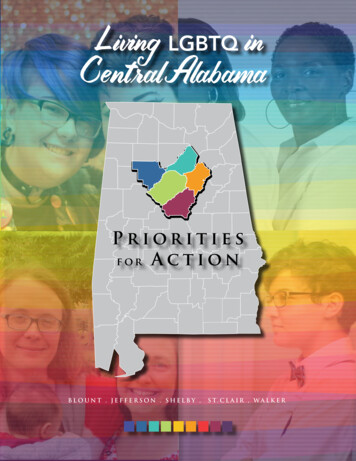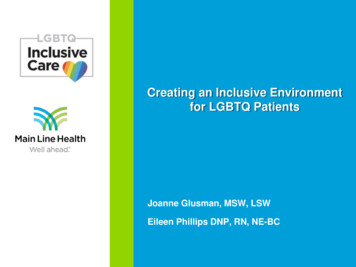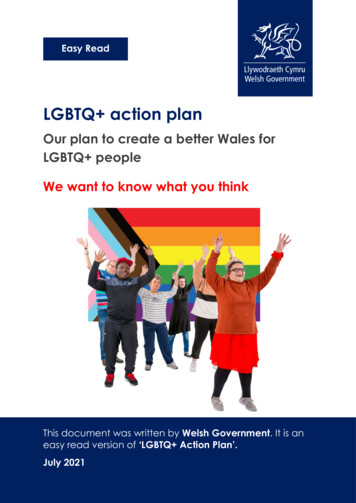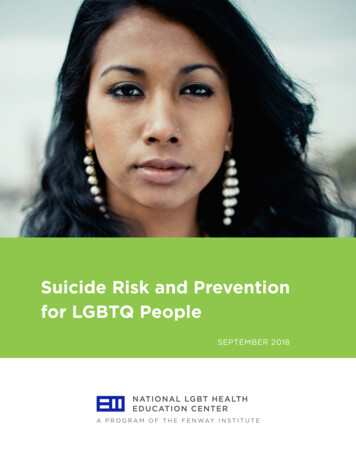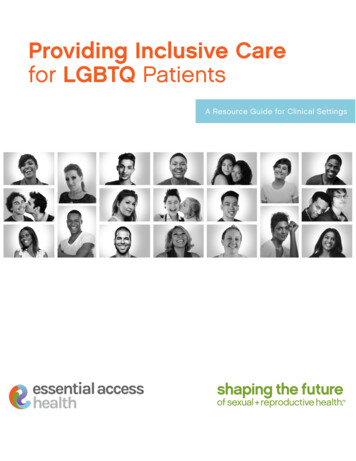
Transcription
Providing Inclusive Carefor LGBTQ PatientsA Resource Guide for Clinical Settings
Providing Inclusive Care forLGBTQ Patients1Introduction3Background Statistics LGBTQ Health 101 Data Resources4Training LGBTQ Cultural Competence Webinars Clinical Care Webinars Additional Trainings on LGBTQ Health andSexual and Reproductive Health7Policies Protocols Non-Discrimination Policies Minor Consent and Confidentiality8Intake Forms Electronic Health Records Sample Intake Forms Electronic Health Records (EHR)9LGBTQ Inclusive Materials Events Inclusive Clinic, Outreach and Website Materials LGBTQ-Friendly Provider Directories Minor Consent and Confidentiality Materials Inclusive Healthcare Coverage Materials Prevention Education12Clinical Care of LGBTQ Patients Providing Culturally Competent Care Comprehensive Sexual History-taking STD/HIV Screening Recommendations PrEP and PEP Evidence-Based Interventions15Additional Resources16Resources for Youth18Appendices: Self-Assessment Toolcontents
“People who are lesbian, gay, bisexual, or transgender (LGBT) are members of everycommunity. They are diverse, come from all walks of life, and include people ofall races and ethnicities, all ages, all socioeconomic statuses, and from all partsof the country. The perspectives and needs of LGBT people should be routinelyconsidered in public health efforts to improve the overall health of every personand eliminate health disparities. - Centers for Disease Control and Prevention1“introductionEssential Access Health champions and promotes quality sexual andreproductive health care for all. Essential Access Health achieves its missionthrough an umbrella of services including clinic support initiatives, advancedclinical research, provider training, patient education, advocacy and consumerawareness. Essential Access Health funds sexual and reproductive healthservices for low-income and uninsured clients through nearly 70 health careorganizations collectively operating nearly 340 health centers serving more thanone million women, men and teens annually in 38 of California’s 58 counties.This resource toolkit is designed to assist healthcare agencies in meeting the needs of their lesbian,gay, bisexual, transgender and queer (LGBTQ) patients. Approximately four percent of adults in Californiaidentify as LGBT.2 Among youth aged 15-21 estimates are higher, with seven percent of young menand fourteen percent of young women identifying as gay, lesbian, bisexual, or other.3 However, manyLGBTQ individuals experience barriers to healthcare access and may delay seeking care out of fear ofhomophobia, discrimination, and receiving inferior care as a result of their sexual orientation or genderidentity.4,5While the LGBTQ community is diverse, significant health disparities that broadly impact this populationhave been identified. National studies have demonstrated that LGBTQ youth are more likely than theirheterosexual peers to experience harassment and violence at school; more likely to abuse alcohol anddrugs; at higher risk for sexually transmitted diseases (STDs), HIV/AIDS, and unplanned pregnancy; lesslikely to seek preventive health services; more likely to experience homelessness; and 2-3 times morelikely to attempt suicide.6, 7, 8, 9Among LGBTQ adults, high rates of smoking and substance use, heart disease, stress and mentalhealth disorders, and intimate partner violence have been identified as issues of significant concern.Gay, bisexual, and other men who have sex with men (MSM) are at increased risk for cancers, includingprostate, testicular, colon and anal cancers; eating disorders; and STDs/HIV. Lesbian, bisexual, and otherwomen who have sex with women (WSW) are more likely than heterosexual women to be obese, andhave higher rates of cancers, including breast and cervical cancers. Transgender women, particularlytransgender women of color, experience high rates of physical violence and sexual assault, and extremelyhigh rates of suicidal ideation and attempts.10Additionally, certain sub-populations within the LGBTQ community are disproportionately impacted byHIV/AIDS. While men who have sex with men (MSM) account for only 4% of the male population of theUnited States, they make up approximately half of all persons living with HIV and two-thirds of newinfections annually.11 Young men who have sex with men (YMSM), particularly black and Latino YMSM, areat highest risk of infection.12 In recognition of the unique needs of this population, this toolkit highlightsseveral resources that specifically address STD and HIV prevention among MSM, and black and LatinoMSM in particular.1Providing Inclusive Care for LGBTQ Patients Essential Access Health
In order to promote positive healthcare seeking behavior, it is critical that clinics provide inclusive,culturally competent services to their LGBTQ patients. In 2014, Essential Access Health conducted a surveyof school-based health centers in Los Angeles County. The survey assessed: Agency-wide policies and practices, such as the inclusion of sexual orientation and genderidentity in patient non-discrimination policies, and the ability of patients to identify as LGBTQ inintake forms and electronic health record (EHR) systems; Staff training on culturally competent service provision for LGBTQ patients; The physical environment, including the availability of inclusive educational materials andmessages in the clinic setting; and Critical clinical services, including whether providers are familiar with current STD/HIVscreening and other health recommendations for LGBTQ patients.Several gaps in current knowledge and practice were identified among school-based health centers,including a lack of available inclusive materials in many clinics, and low respondent knowledge regardingcritical clinical issues such as screening recommendations for LGBTQ patients and the importance oftaking and documenting routine, culturally competent sexual histories.This toolkit is structured to help healthcare agencies strengthen their practices by providingrecommended resources and best practices. The first section includes resources related to internalorganizational issues, such as staff training and agency policies. Subsequent sections reflect clinicflow, addressing topics that patients will encounter as they go through the process of a clinic visit: firstencountering the physical environment of the clinic, followed by recommended clinical services, andending with resources for referrals and additional information. Finally, the appendix includes a selfassessment tool that can be used to identify gaps or barriers in providing LGBTQ-inclusive services withinyour healthcare setting. Utilizing the self-assessment first is recommended in order to identify whichsections in the toolkit to prioritize and focus on initially.A note on terminology: throughout this toolkit, the terms LGBTQ and LGBT will be used at various times.The distinction is based on the population specified and/or terminology used in the linked resource.Please contact Essential Access Health’s STD Prevention Program at STDPrograms@essentialaccess.orgwith any questions or requests for further technical assistance.2Providing Inclusive Care for LGBTQ Patients Essential Access Health
background statisticsThe following resources provide an introduction to LGBTQ health topics,terminology, and sources for current data and research on LGBTQ populations.I. LGBTQ Health 101: Terminology Major Health Issues Straight for Equality: LGBTQ Glossary. A list of terms to assist staff in conversations aboutLGBTQ health. GLAAD: Transgender 101. An introduction to key concepts about gender identity andtransgender individuals. SAMHSA: Top Health Issues for LGBT Populations Information & Resource Toolkit. Terms anddefinitions of sexual and gender identity for providers, as well as a summary of the top healthissues affecting lesbians, gay men, bisexual men and women, and transgender people. Institute of Medicine (IOM): The Health of Lesbian, Gay, Bisexual, and Transgender People:Building a Foundation for Better Understanding. The IOM report is a seminal document thatoutlines the current status of LGBT health and health research in the United States.II. Data ResourcesCenters for Disease Control and Prevention (CDC): Lesbian, Gay, Bisexual and Transgender Health. TheCDC’s LGBT health website contains data and reports, fact sheets, best practices and resources related tothe diverse health needs of LGBT adults and youth. Selected fact sheets include: LGBT Youth Gay Men and STDs Fact Sheet HIV and Young Men Who Have Sex with Men Fact Sheet HIV Among African American Gay and Bisexual Men HIV Among LatinosCenters for Disease Control and Prevention (CDC): Youth Risk Behavior Surveillance System (YRBSS). TheYRBSS monitors 6 types of health-risk behaviors, including: injury and violence; sexual behaviors; alcoholand drug use; tobacco use; dietary behaviors; and physical activity. This data can be used to comparehealth risks between heterosexual and gay, lesbian and bisexual (GLB) youth in select districts. Sexual Identity, Sex of Sexual Contacts, and Health-Risk Behaviors Among Students in Grades9-12 – Youth Risk Behavior Surveillance, Selected Site, United States, 2001-2009Los Angeles Unified School District (LAUSD): Youth Risk Behavior Survey (YRBS) Data 2013 LAUSD YRBS Risk Behavior and Sexual Identity Report. This report specifically comparesdata between heterosexual and gay, lesbian and bisexual (GLB) students, indicating wherehealth disparities exist.County of Los Angeles Public Health, Division of HIV and STD Programs: ReportsThe Division of HIV and STD Programs (DHSP) publishes HIV and STD surveillance reports, whichprovide rates by age, gender, and race/ethnicity as well as service planning area/health district.Useful resources include: 2013 Annual HIV Surveillance Report Los Angeles County STD Morbidity Annual Report 2012Gay, Lesbian & Straight Education Network (GLSEN): The National School Climate Survey reports on theexperiences of LGBT youth in schools, the extent of the challenges that they face at school, and insightsinto many other aspects of LGBT students’ experiences.The Williams Institute: A national think tank at UCLA Law, the Williams Institute publishes research onsexual orientation and gender identity law and public policy. Research topics include LGBT census anddemographics, health and HIV/AIDS.3Providing Inclusive Care for LGBTQ Patients Essential Access Health
“As we learn more about health disparities and effective programs to address them,medical care providers, public health workers, and other human services workerswho interact on a daily basis with LGBT persons will need training. Without suchtraining, sexual and gender minorities will continue to interact with a health caresystem that is unaware, insensitive, and unprepared to meet their needs.- Kenneth H. Mayer, et al.13The following resources can be used to develop or enhance your agency’strainings regarding LGBTQ health and providing culturally competent services.Many of the included webinars are one hour or less and can be viewed ondemand at no charge. Those that offer CME/CEUs are indicated.“trainingBest Practices in Creating and Delivering LGBTQ Cultural Competency Trainings for Health and SocialService Agencies: Developed by the National LGBT Cancer Network, this manual provides comprehensiveguidance and best practices for designing and evaluating an LGBTQ cultural competency training for youragency.I. Cultural Competence WebinarsGLMA: Cultural Competence Webinar SeriesThis 4 part webinar series explores the health concerns and healthcare needs of LGBT people in order tocreate a comprehensive system of care that supports positive outcomes and experiences.The National LGBT Health Education Center: Meeting the Health Care Needs of Lesbian, Gay, Bisexual andTransgender People: The End of LGBT Invisibility. This webinarprovides an overview of LGBT health disparities, demographics, andterminology, as well as key strategies for bringing high quality careto LGBT people at health centers and health care organizations.(CME/CEU available) Creating an Inclusive Environment for LGBT Patients and Staffat Your Health Center. LGBT people, like all population groups,want to receive health care in environments in which they feelwelcome, included, respected, and understood. This webinardescribes strategies and model policies for creating LGBTinclusive health care spaces. (CME/CEU available) Caring for LGBT Youth in Clinical Settings.This webinar discusses the unique health anddevelopmental challenges of LGBT youth, anddescribes ways to address these issues in theclinical setting. Through sensitive, confidentialcommunication with LGBT youth, clinicianscan become a vital source of support for thisvulnerable population. (CME/CEU available)4Providing Inclusive Care for LGBTQ Patients Essential Access Health
YMSM LGBT Center of Excellence: Young MSM: The People Behind the Epidemiological TermRacial and ethnic minority young men who have sex with men (YMSM) experience high rates of HIVtransmission. This webinar presents findings about risks in these populations. A panel discussion includesyoung people who describe their personal experiences, providing insight into why these communities ofyoung men are at increased risk. (CE/CEH available)The Center of Excellence for Transgender Health (UCSF): Acknowledging Gender and Sex. Thisinteractive online course provides information for providers and clinic staff on developing a welcomingenvironment for transgender patients, including scripts for discussing gender identity with patients.Children’s Hospital Los Angeles SYPP Center: The Center for Strengthening Youth Prevention Paradigms(SYPP Center) within the Division of Adolescent and Young Adult Medicine at Children’s Hospital LosAngeles disseminates best practices for HIV prevention among youth, particularly young gay and bisexualmen and transgender youth of color. Recorded webinars on a variety of topics are available. Cultural Competency for Medical Providers and Research Staff Working with Transgender YouthTARGET Center: Optimizing Linkage, Engagement, and Retention in HIV Care for Adolescents and YoungAdults of Color. Presented by Fenway Health and the Sidney Borum Jr. Health Center, this webinardescribes how racial justice-focused initiatives and partnerships between providers and communitybased organizations can optimize efforts to link youth of color to care.II. Clinical Care WebinarsThe National LGBT Health Education Center: HIV and STI Prevention Strategies for Gay/Bisexual Men andTransgender People in Primary Care. This four-part webinar series, sponsored by the New England AIDSEducation and Training Center, explores critical topics in HIV/STI prevention. (CME/CEU available) Taking a History of Sexual Health: Opening the Door to Effective HIV and STI Prevention Screening and Testing for Sexually Transmitted Infections in Gay, Bisexual and Other Men WhoHave Sex with Men Pre-Exposure Prophylaxis (PrEP): Implementation Challenges and Successes Understanding and Assessing the Sexual Health of Transgender PatientsAmerican Medical Association: Patient Sexual Health History: What You Need to Know to HelpThe AMA has recently developed a video to educate physicians on best practices when taking a sexualhistory. Often times, it is the sexual history that reveals additional important information about the patient,such as their sexual orientation or gender identityThe California STD/HIV Prevention Training Center offers online and in-person courses and technicalassistance for health professionals. Selected online learning resources include: Self-Study STD Modules for Clinicians (CME available) HIV Today: What Everyone Needs to Know Social Determinants of Health and HIV (CEU available) A Practical Approach to Implementing HIV Pre-Exposure Prophylaxis (CME available) Delivery of the Positive HIV Test Result (CME available) Taking a Sexual History Extragenital Testing for Gonorrhea and Chlamydia in MSM At the Crossroads: Current Challenges for MSM of Color LGBTQQI Sensitivity5Providing Inclusive Care for LGBTQ Patients Essential Access Health
III. Additional Webinars Related to LGBTQ Health and Sexual Reproductive HealthNational Center for Innovation in HIV Care: Reaching and Connecting LGBTQ Communities to ACACoverage Options. LGBTQ persons are more likely to be uninsured than non-LGBTQ persons due tohistoric barriers to healthcare access. This webinar discusses the influence of the ACA on access tohealth care for LGBTQ people as well as best practices for agencies working to reach, assist, and connectLGBTQ communities to ACA coverage options.Essential Access Health: Essential Access Health’s Learning Exchange frequently offers webinars and inperson trainings for health professionals. Select recorded webinars include: Sexual Reproductive Health: Focus on LGBTQ Patients Sexual Reproductive Health: Focus on Transgender Patients Sexual Reproductive Health: Focus on Adolescents Quality Family Planning Counseling (includes motivational interviewing techniques)Additionally, in partnership with the California Department of Public Health, STD Control Branch andpartner organizations, Essential Access Health has developed the Sexual Health Educators (SHE) TrainingProgram. Designed for educators in school, community, and clinic settings who want to build theirknowledge and capacity in sexual health and sexuality education; upon the successful completion ofrequired courses, participants will receive a Certificate of Completion as a Sexual Health Educator.6Providing Inclusive Care for LGBTQ Patients Essential Access Health
“When a healthcare organization includes the terms “sexual orientation” and “genderidentity” in its patient non-discrimination policy, it sends an important messageto patients and employees alike: LGBT people must receive equal treatment Statements that healthcare organizations are committed to LGBT non-discriminationare deeply appreciated by LGBT members of the community and provide importantguidance to employees. - Human Rights Campaign14“policies protocolsPolicies and protocols establish standard practice within an agency; havingLGBTQ-inclusive policies and protocols is crucial to ensure high quality carefor all patients. This section contains templates and sample policies thatyour health center may adopt or incorporate into current clinical practices.I. Non-Discrimination PoliciesThe following organizations have published sample LGBTQ-inclusive non-discrimination policies: Human Rights Campaign: Sample Non-Discrimination Policies Straight for Equality: Sample Non-Discrimination PolicyII. Minor Consent and ConfidentialityThe following resources outline current laws regarding minor consent andconfidentiality in California, and can be used to develop or update youragency’s policies regarding confidential care for minor patients. California Adolescent Health Collaborative: UnderstandingConfidentiality and Minor Consent Toolkit. This toolkit providesguidance on minor consent and confidentiality laws in Californiafor providers, including explanations regarding mandatoryreporting and educational materials for youth and parents. My Health My Info: Provider and Patient Education Materials.“Youth list concerns about confidentiality as the number one reason they might forgomedical care. For this reason, youth need assurances of privacy and confidentialitywith their healthcare providers. - Duplessis, Goldstein, & Newlan157Providing Inclusive Care for LGBTQ Patients“Resources to assist providers in educating patients about theirconfidentiality rights and new privacy protections. Developedin partnership by the ACLU of Northern California, ACLUof Southern California, Essential Access Health and theNational Center for Youth Law. All materials are availableto download for free. Essential Access Health
“Gathering sexual orientation and gender identity data in a standardized way willallow us to better understand LGBT health disparities, as well as to prevent, screenand early detect conditions that disproportionately affect LGBT people. Gatheringsuch data in clinical settings will allow providers to better understand and treat theirpatients, and to compare their patients’ health outcomes with national samples ofLGB or LGBT people from national health surveys. - The Fenway Institute16Intake forms and EHR systems can be used to capture important informationregarding patients’ sexual orientation and gender identity. Additionally, utilizinginclusive intake forms and language indicates to LGBTQ patients that they arewelcome in your healthcare setting.“intake forms electronic health recordsI. Sample Intake Forms Fenway Institute: How to Gather Data on Sexual Orientation and Gender Identity in ClinicalSettings. This brief discusses two methods for collecting data on sexual orientation and genderidentity from patients, using intake forms and provider discussions documented in the EHRsystem. Examples of best practices are provided. Straight for Equality: Sample Intake Form. An example of an inclusive intake form.II. Electronic Health Records (EHR)National LGBT Health Education Center (Fenway Institute): These briefs explain why collecting sexualorientation and gender identity (SOGI) data will help providers better understand the needs of their LGBTpatients, and provide specific guidance on how to ask questions about SOGI, collect data using EHRsystems, and address confidentiality issues. Why Gather Data on Sexual Orientation and Gender Identity in Clinical Settings How to Gather Data on Sexual Orientation and Gender Identity in Clinical Settings Collecting Sexual Orientation and Gender Identity Data in Electronic Health Records: Taking theNext StepsInstitute of Medicine (IOM): Collecting Sexual Orientation and Gender Identity Data in Electronic HealthRecords - Workshop Summary. In 2011, the IOM recommended that information on patients’ sexualorientation and gender identity (SOGI) should be collected in electronic health records, just as informationon race and ethnicity is routinely collected. This report summarizes recommendations for documentingSOGI data in EHR systems.U.S. Department of Health and Human Services Office of Minority Health: Improving Data Collection forthe LGBT Community. Fact sheet regarding HHS’ efforts in developing a national data progression planintended to begin the integration of sexual orientation and gender identity variables into HHS nationalsurveys.8Providing Inclusive Care for LGBTQ Patients Essential Access Health
“Lesbian, gay, bisexual, and transgender (LGBT) patients often “scan” an office forclues to help them determine what information they feel comfortable sharing withtheir health care provider. - GLMA17“LGBTQ inclusive materials eventsThe following resources define what it means to have an LGBTQ-inclusive clinicalenvironment and provide guidance for designing inclusive spaces and providingtargeted outreach. Many of the materials listed below are available to agencies atlow or no cost.GLMA’s Creating a Welcoming Clinical Environment for Lesbian, Gay, Bisexual, and Transgender (LGBT)Patients describes strategies for creating an inclusive and welcoming environment for your LGBT patients.Additional resources are included below.I. Inclusive Clinic, Outreach Website MaterialsGay, Lesbian & Straight Education Network (GLSEN): The Safe Space Kit: A Guide to Supporting Lesbian,Gay, Bisexual and Transgender Students in Your School provides concrete strategies to create a safespace for LGBT students. Although the target audience for the toolkit is schools, the terminology andstrategies to combat anti-LGBT bias are also useful for clinic settings. GLSEN also provides inclusivematerials: Safe Space Poster free download; also available to purchase. Safe Space Stickers free download (for Avery label 5163); also available to purchase. Educator Events Calendar This calendar includes key LGBT, social justice and diversity datesthroughout the school year.Centers for Disease Control and Prevention (CDC): Adolescent and School Health Calendar of Events. Acalendar of various awareness days and health information dates.Examples of LGBTQ Inclusive Websites: Including LGBTQ-specific health information on your agency’swebsite indicates to patients that they are welcome in your clinic, and can provide targeted healtheducation and information regarding specialized services. Mount Sinai Beth Israel: LGBT Health Services St. John’s Well Child & Family Center: Transgender Health ProgramII. LGBTQ-Friendly Provider DirectoriesIn addition to developing LGBTQ-inclusive websites, health agencies may opt to participate in LGBTQfriendly provider directories. These allow patients to search for clinics or providers who are knowledgeableand comfortable with LGBTQ individuals and their health needs.The Healthcare Equality Index (HEI), developed and maintained by Human Rights Campaign (HRC), is thenational LGBT benchmarking tool that evaluates healthcare facilities’ policies and practices related to theequity and inclusion of their LGBT patients, visitors and employees. Healthcare organizations can requestto participate in the HEI. It is designed for hospitals and other inpatient healthcare facilities with at least100 employees.Smaller medical groups, outpatient behavioral health organizations and solo health practitioners areencouraged to participate in the GLMA Provider Directory.9Providing Inclusive Care for LGBTQ Patients Essential Access Health
III. Minor Consent, Confidentiality, and Students Rights Clinic and Outreach MaterialsCalifornia Adolescent Health Collaborative: Teen Confidentiality Poster for Healthcare Settings Provider to Parent/Guardian LetterMy Health My Info: Provider and Patient Education Materials. Resources to assist providers in educatingtheir patients about their confidentiality rights and new privacy protections. Developed in partnership bythe ACLU of Northern California, ACLU of Southern California, Essential Access Health and the NationalCenter for Youth Law. All materials are available to download for free.ACLU of Southern California: LGBTQ Student Rights Project Your Health Your Rights Information for teens about privacy and reproductive health care. LGBTQ Students Know Your Rights Information for LGBTQ students regarding their rightson issues including harassment in school, freedom of speech, student privacy, gay-straightalliances and sex education. Trans Students Know Your Rights Information for transgender and gender nonconformingstudents regarding their rights to privacy, preferred name and gender pronouns, and issuessuch as bathroom use, dress codes, and harassment or bullying.IV. Inclusive Healthcare Coverage MaterialsWhere to Start, What to Ask: A Guide for LGBT People Choosing Healthcare Plans. Developed by StrongFamilies and a coalition of partners, this guide is designed to assist LGBT individuals in evaluating theirhealthcare needs, navigating new insurance options, and choosing the bestplan for themselves and their family.Optimizing LGBT Health Under the Affordable Care Act: Strategies forHealth Centers. Developed by the Center for American Progress andthe National LGBT Health Education Center of the Fenway Institute, thisbrief outlines ways in which the ACA can improve LGBT health as wellas outreach strategies for health centers.V. Prevention EducationCalifornia Education CodeEducational materials or presentations designed for use withadolescents in school-based settings should adhere to theCalifornia Education Code. Below are selected resourcesrelated to the Education Code, requirements for healtheducation, and specific guidance related to sexual healtheducation. Health Education Content Standards for CaliforniaSchools Kindergarten through Grade TwelveThe Health Education Content Standards arethe framework for health education instructionin California public schools, developed by acommittee of health educators and teachers. California Comprehensive Sexual Health & HIV/AIDSPrevention Act defines the legal requirements andguidelines for sexual health educations and HIV/AIDSprevention education in California public schools.10Providing Inclusive Care for LGBTQ Patients Essential Access Health
Health Education Curriculum Analysis Tool The Health Education Curriculum Analysis Tool (HECAT) is the CDC’s tool for evaluating theeffectiveness and appropriateness of health education curricula, based on the National HealthEducation Standards and CDC’s Characteristics of an Effective Health Education Curriculum.This tool can be used to evaluate, select and strengthen health education programs. Modulesaddress specific health topics, including sexual health.VI. Prevention Education MaterialsProviding LGBTQ-inclusive health education materials, such as brochures and pamphlets, relays criticalhealth information to LGBTQ patients, and indicates that their health needs are a priority in your clinicalsetting. Agencies may consider developing their own health education materials, or purchasing materialsthat are designed to be LGBTQ-inclusive.The following organizations publish age appropriate, evidence-based education materials covering avariety of health topics including STD/HIV prevention. Channing Bete ETR Associates Journeyworks SexpressionsAdditional Resources for Inclusive Health EducationCDC: The Facts Brochures provide comprehensive information on STDs that can be downloaded orordered. Available in English and Spanish.The California Health Kids Resource Center maintains a comprehensive collection of reviewed healtheducation materials, made available to schools and professionals working with students. Edu
heterosexual peers to experience harassment and violence at school; more likely to abuse alcohol and drugs; at higher risk for sexually transmitted diseases (STDs), HIV/AIDS, and unplanned pregnancy; less likely to seek preventive health services; more likely to experience homelessness; and 2-3 times more likely to attempt suicide.6, 7, 8, 9

